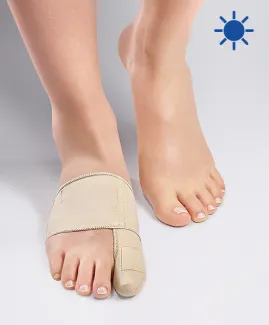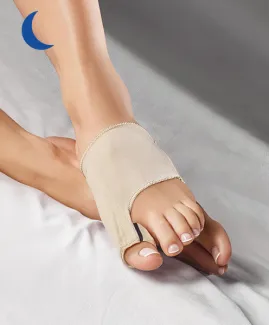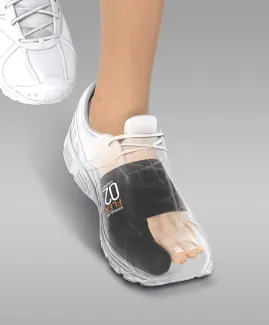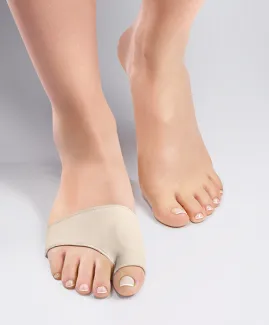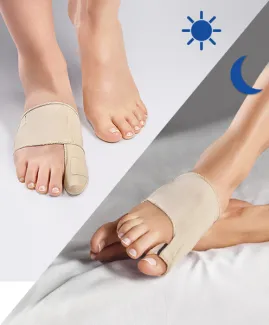
It is not easy to choose the most effective bunion corrector that will realign the big toe and reduce the bunion deformity. This very common condition affects between 23 and 35% of the population(1). Inevitably, popular beliefs about bunion correctors appear... EPITACT® buries the myths and reveals the truths regarding toe straightening related to a bunion, also known as hallux valgus.
1) A bunion corrector is specifically dedicated to women.
TRUE & FALSE! Both women and men can wear a bunion corrector. Indeed, it is available in different sizes to suit everyone. EPITACT®, podiatric and orthopaedic care specialist, suggests protections and braces* for men and women. The rigid brace* is heat-moulded to better adapt to your morphology. Directly thermoformed on you, it perfectly fits the shape of your foot. In this way, you can change the degree of correction. This medical device gently realigns the big toe.
The bunion corrector is often associated with women because this condition mainly affects this category of the population. More than 90% of cases are women. The toe deformity and the formation of a bunion mainly occur in women around 50 years old. Indeed, the decline of hormones during menopause can contribute to excessive laxity of the joint. This female prevalence can also be explained by the wearing of narrow high heels (rarer in men 😉). These shoes compress the toes and deviate the big toe. Moreover, the height of the heel leads to body weight transfer in the forefoot, which favours the deformity.
2) Surgery is the most effective bunion corrector.
FALSE! Surgery is the treatment of last resort for this condition. It is performed in advanced cases, when too intense pains make walking difficult and when the big toe doesn’t move laterally anymore. For mild to moderate cases, wearing shoes more adapted for the foot is suggested as a first-line approach. Also, it is recommended to use a brace, also called bunion straightener or bunion corrector. This kind of medical device is effective to prevent or limit the progression of hallux valgus. Therefore, EPITACT® offers a range of bunion correctors whose effectiveness has been validated in a clinical study. Discover the flexible brace* and rigid brace* to limit pain and deformity. A third device is the flexible bunion brace for sport* that protects the bunion from frictions and pressures during sports activities.
3) A bunion corrector is always uncomfortable and correction is painful.
FALSE! Hallux valgus can be uncomfortable, even disabling when wearing shoes or walking. Since it is a condition that progresses slowly and gradually, the onset of pain can be late. It especially manifests because of frictions between the joint and the shoe or because of excessive pressures in the forefoot. If left untreated, other associated pain may appear: claw/hammer toes, corns, calluses or joint pain.
Bunion correctors are intended to realign the toe without impeding movements or reducing your comfort. A bunion corrector aims to relieve and prevent the pain caused by the condition. Many braces exist and the choice can become difficult, especially if it’s based on quality. Therefore, it is better to look for qualitative ranges of products combining effectiveness and comfort like the EPITACT®braces.
4) There is a high risk of recurrence after wearing a bunion corrector.
FALSE! Recurrence of a bunion is possible, especially if its causes are not eliminated. This is why prevention is always important. However, some factors can favour the bunion recurrence: obesity, smoking, non-compliance with treatment, hypermobility of the first ray or no change of shoe habits (high heels, narrow or tight shoes).
Find out our article dedicated to hallux valgus recurrence, especially after surgery.
5) A bunion corrector realigns the toe in just a few days.
FALSE! It takes time to correct the deformity, even with a very effective bunion corrector. When wearing a brace, the correction is immediate, but for a lasting realignment of the toe, patience is essential. Hallux valgus is a deformity that cannot disappear over time. Also, to stop the progression of the toe deformity, follow your doctor’s recommendations regarding complementary treatments. Finally, you can do muscle strengthening and stretching exercises that will extend the joint flexibility.
*These solutions are class I medical devices that bear the CE marking under this regulation. Carefully read the instructions before use. Manufacturer: Millet Innovation. 11/2021
For more details about this general and simplified approach, here is another source:
(1)Heyes GJ, Vosoughi AR, Weigelt L, Mason L, Molloy A. Pes Planus Deformity and Its Association With Hallux Valgus Recurrence Following Sarf Osteotomy. Foot Ankle Int. oct 2020;41(10):1212‑8.
 Pharmacie
Pharmacie